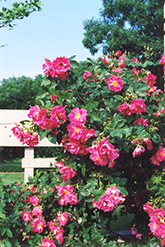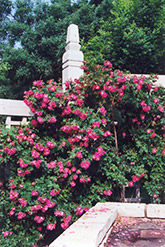Height: 9 feet
Spread: 6 feet
Sunlight:
![]()
Hardiness Zone: 2
Group/Class: Explorer Rose
Description:
Perhaps the hardiest and most vigorous climber available, this exceptional rose has achieved almost legendary status with its seemingly endless procession of semi-double cherry red flowers throughout the summer, wonderful trailing over a fence or arbor
Ornamental Features
William Baffin Rose is bathed in stunning semi-double cherry red flowers with yellow eyes along the branches from late spring to late summer. The flowers are excellent for cutting. It has dark green deciduous foliage. The oval compound leaves turn yellow in fall. The fruits are showy tomato-orange hips displayed from mid to late fall. The spiny brick red bark adds an interesting dimension to the landscape.
Landscape Attributes
William Baffin Rose is a multi-stemmed deciduous woody vine with a twining and trailing habit of growth. Its average texture blends into the landscape, but can be balanced by one or two finer or coarser trees or shrubs for an effective composition.
This is a high maintenance woody vine that will require regular care and upkeep, and is best pruned in late winter once the threat of extreme cold has passed. Gardeners should be aware of the following characteristic(s) that may warrant special consideration;
- Disease
- Spiny
William Baffin Rose is recommended for the following landscape applications;
- Mass Planting
- Hedges/Screening
- General Garden Use
Planting & Growing
William Baffin Rose will grow to be about 9 feet tall at maturity, with a spread of 6 feet. As a climbing rose, it can be leggy near the base and may be concealed by underplanting with lower-growing facer plants. It should be planted near a fence, trellis or other landscape structure where it can be trained to grow upwards on it, or allowed to trail off a retaining wall or slope. It grows at a fast rate, and under ideal conditions can be expected to live for approximately 20 years.
This woody vine should only be grown in full sunlight. It does best in average to evenly moist conditions, but will not tolerate standing water. It is not particular as to soil type or pH. It is somewhat tolerant of urban pollution. This particular variety is an interspecific hybrid.

